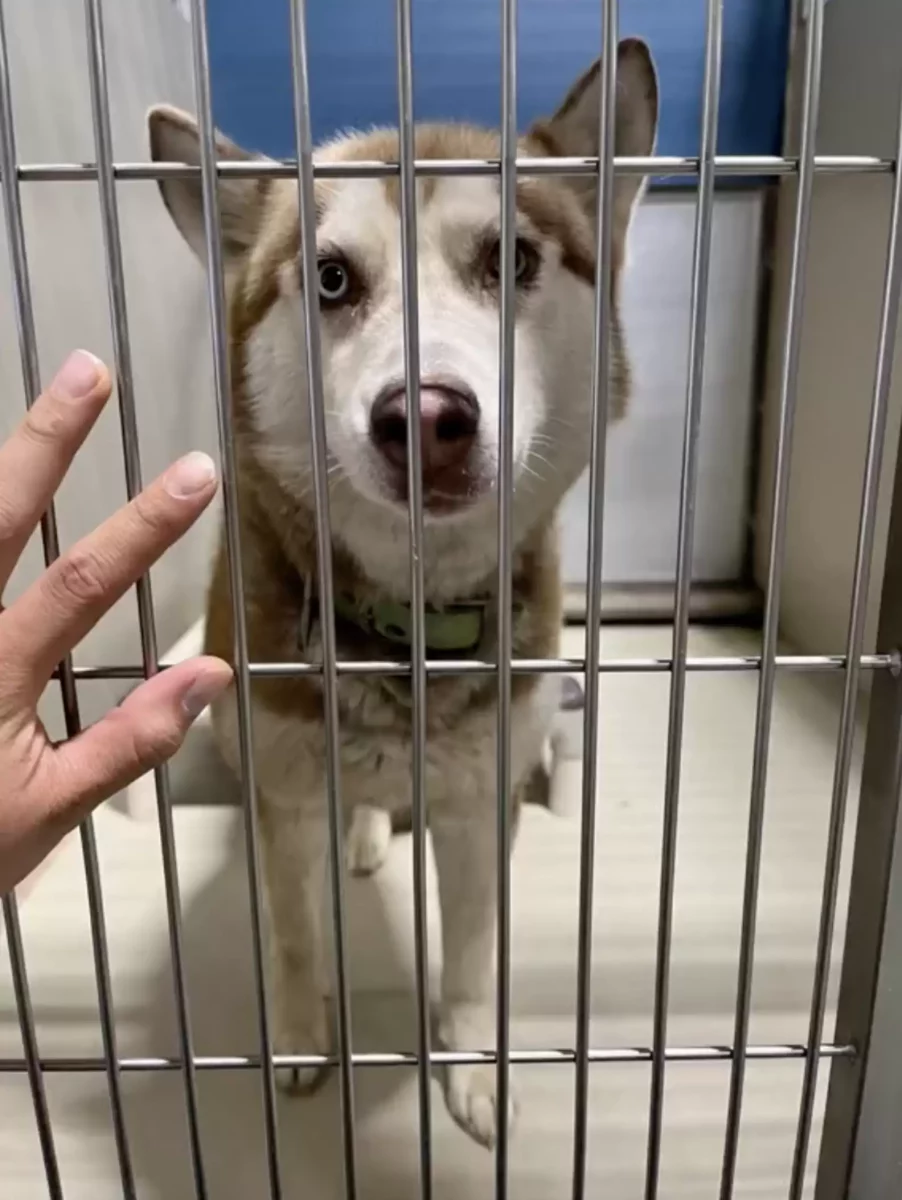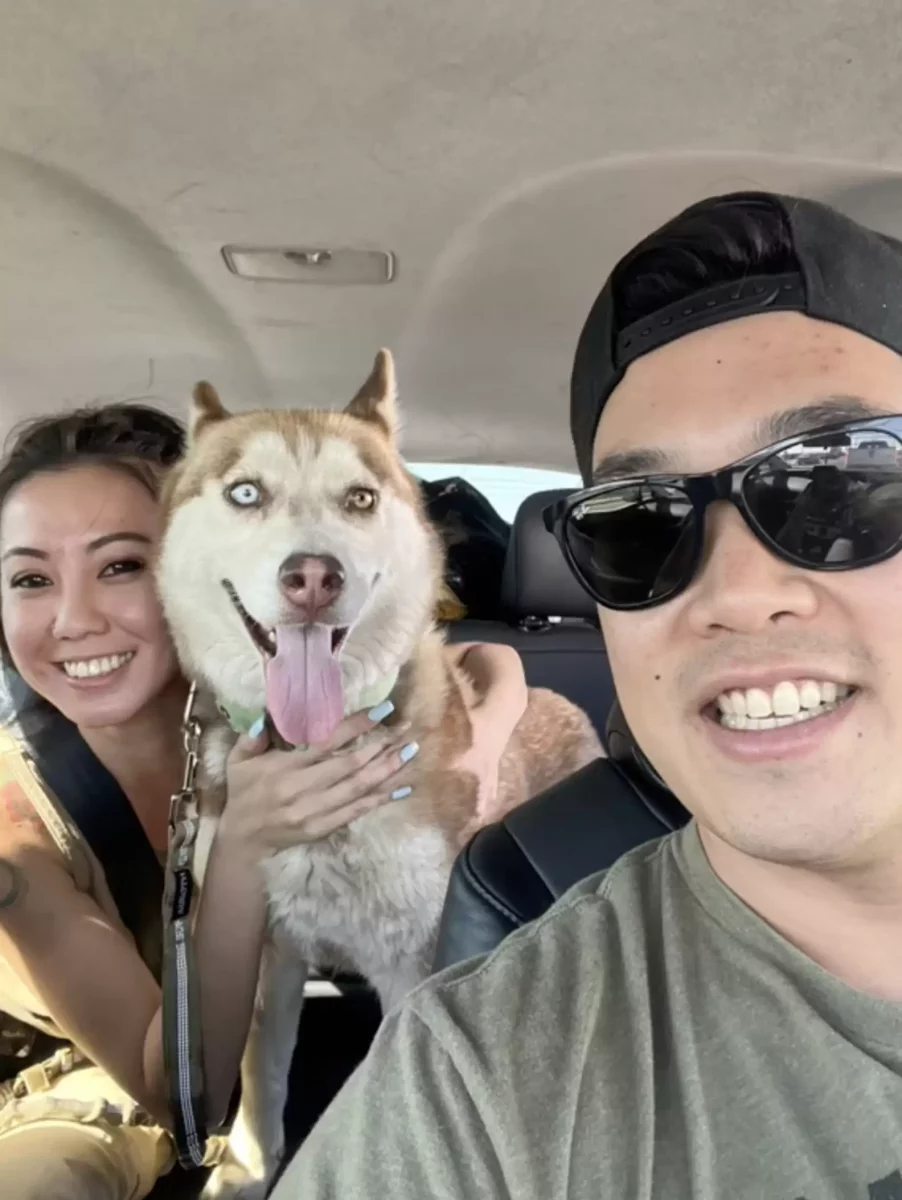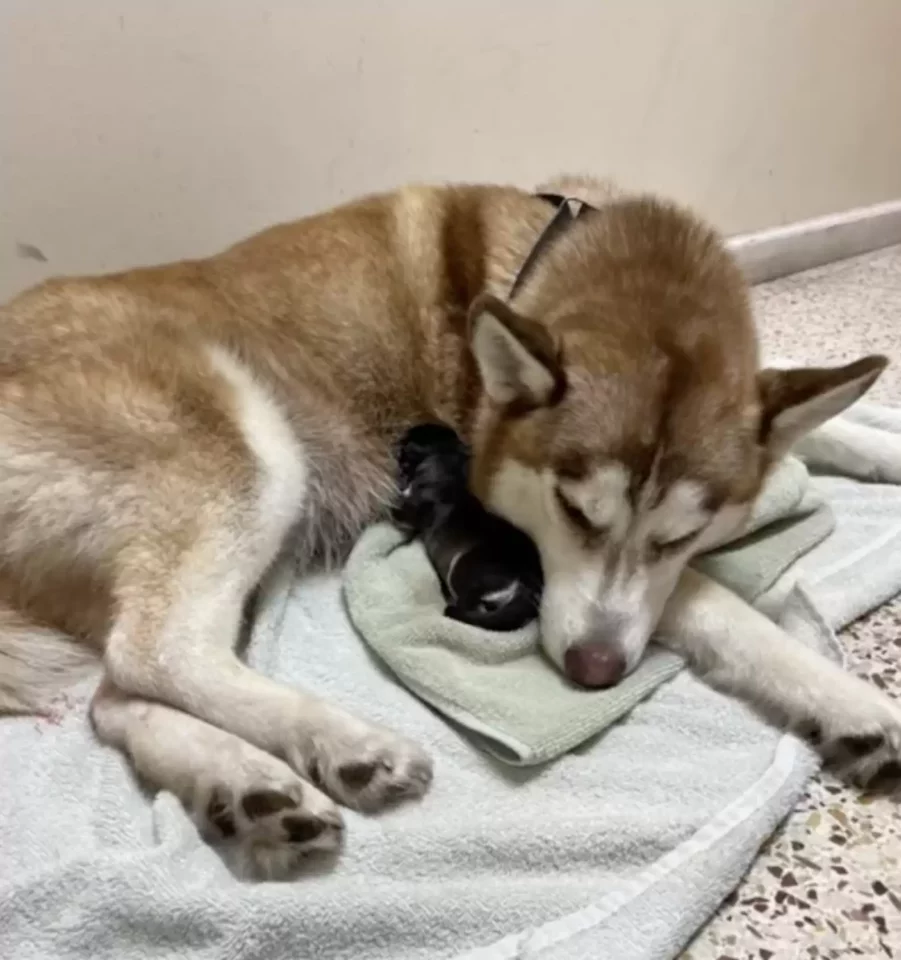Adopting a dog is one of the kindest things you can do for an animal that has spent most of its time in this world in a lot of pain.
So many dogs deserve to find their forever home, but it’s not so easy all the time as many people do not want to adopt.
In this story, we will talk about a kind family who adopted a dog that quite honestly gave them the best surprise.
A New Beginning For A Happy Dog

Earlier this year, a woman named Mickey, and her boyfriend, got the idea of adopting a dog from their local shelter in California.
They wanted to save another happy pup after their previous dog passed away. They weren’t sure if they were even going to find the one, but then they saw Demi.
She was just the most beautiful dog who was always happy around other people.
Mickey (who asked that her last name remain anonymous) said to The Dodo: She was super calm and always had a huge smile on her face. Although she was surrounded by many loud barking dogs, she didn’t make a peep…
We walked her around the aisles of the shelter, and not once did she react to any of the other barking dogs. She even walked herself back into her own kennel.
They were charmed by her personality and decided that they had to take her to their home.
Demi’s Unusual Behavior

Demi was a husky, and not a small dog, but this didn’t deter the couple from taking her in and showering her with affection.
When she was in her new home, they helped her adapt, and everything was great for a while.
Then, out of nowhere, Demi’s attitude changed. She began to act a bit strange.
Mickey said: We didn’t notice anything strange in her behavior at first, except the occasional long naps, which we assumed was just in her nature.
Her energy levels were normal. It wasn’t until she started trying to burrow and den in our closet… She even tore up her favorite bed and lined up her favorite toys in a row nearby. That morning she refused to budge and went on her daily early morning walk.

Her new parents took her to a veterinarian clinic in California to see what was wrong with her. While they were waiting, Demi started giving birth.
The couple had suspected that she was pregnant but brushed it off because they had thought that the shelter workers where Demi lived would have told them that important fact.
However, the real reason why they didn’t know was because the shelter she was in had a lot of issues with funding, it was also overcrowded and mistakes like this can simply happen to anyone.
A New Dog Family

During her pregnancy, they noticed that Demi was as calm as usual, and that surprised them a lot.
After giving birth to 5 puppies, they had to come up with some names for all of them. The little babies were named Bree, Bale, Jo, Grey, and Ari.
Even though Demi was exhausted, she did her best to take care of her new puppies and it showed just how affectionate she was.

Mickey said: She never ceases to amaze us with how great her motherly and nurturing nature is.
Time had gone by and the little pups had grown quite a bit, and are living a very happy life with their mom and human siblings.
Despite not expecting this sort of development, Mickey and her boyfriend were over the moon with how things turned out, and they are doing their best to take care of their new furry companions.
If you are curious, you can watch the dogs grow up on Demi’s own TikTok page.
Ever experienced that sinking feeling when your furry friend suddenly bolts out the door or disappears during a walk? It’s a heart-wrenching moment that many dog owners can relate to. Understanding why dogs have the instinct to run away is crucial in keeping them safe and secure. As a seasoned dog trainer, I’ve witnessed firsthand the various reasons behind this behavior, and it goes beyond mere wanderlust.
Dogs running away can stem from a combination of factors, from boredom and curiosity to fear or even a desire to socialize with other dogs. It’s essential to grasp the underlying motivations behind this behavior to prevent it from happening in the future. By delving into the psychology of why dogs run away, we can take proactive steps to ensure our beloved companions stay by our side where they belong.
Understanding the Canine Mindset
The Instinct to Roam
Dogs have a natural instinct to explore their surroundings, which can lead them to run away. This behavior is influenced by their ancestors, who were hunters and roamers. Your furry friend may feel the urge to wander due to their innate need to investigate new scents, sights, and sounds. Understanding this primal instinct helps you appreciate why they sometimes bolt unexpectedly.
Anxiety and Stress Responses
Anxiety and stress can also trigger a dog to run away. Just like humans, dogs can experience feelings of unease and tension. Loud noises, unfamiliar environments, separation anxiety, or traumatic experiences can all contribute to your dog’s decision to escape. When feeling overwhelmed, your dog might seek solace by fleeing to a perceived safer place. Recognizing these emotional triggers is crucial in addressing and preventing your dog from running away.
Common Triggers for Canine Escapism
A Loud Noise or Sudden Event
Dogs have sensitive hearing, so loud noises like thunderstorms, fireworks, or even construction sounds can startle them. When scared, dogs might instinctively run away seeking safety from what they perceive as a threat. If your dog bolts after a loud noise, it’s likely a fear response, and ensuring a safe environment during such events is essential to prevent escapes.
Boredom or Lack of Exercise
Dogs are active animals that need mental and physical stimulation to stay content. When they’re bored or not getting enough exercise, they may try to escape to find excitement or to release pent-up energy. Providing adequate playtime, walks, and engaging toys can help prevent your furry friend from seeking adventure beyond the boundaries of your home.
Inadequate Training and Boundaries
Proper training and clear boundaries are crucial in preventing dogs from running away. If your dog hasn’t been taught basic commands like “stay” or “come” or if your property lacks secure fencing, your dog may see an opportunity to wander. Establishing consistent training routines and ensuring your dog respects boundaries can significantly reduce the chances of escape.
Remember, understanding the triggers that prompt your dog to run away is the first step in addressing and preventing this behavior. By incorporating adequate measures and creating a safe and stimulating environment for your canine companion, you can help ensure they stay safe and content at home.
The Impact of Breed and Biology
High-Energy Breeds and the Need for Exercise
Some dog breeds are naturally high-energy, requiring ample physical activity to stay content. Breeds like Border Collies and Jack Russell Terriers need more than just a short walk around the block. For these energetic pups, lack of exercise can lead to restlessness and a higher likelihood of trying to escape in search of stimulation. Remember, a tired dog is a happy dog!
Predatory Drives and Pursuit Behavior
Dogs with strong predatory instincts, such as sight hounds like Greyhounds or scent hounds like Beagles, may be prone to chasing small animals or moving objects. This primal behavior can prompt them to run after perceived prey, leading them to bolt if they catch sight or scent of something intriguing. Understanding your dog’s natural instincts can help you anticipate and prevent potential escape attempts.
The Role of Neutering in Preventing Roaming
Neutering plays a significant role in curbing the urge to roam, especially in male dogs. Unneutered males are more likely to wander off in search of a mate, driven by their biological urge to reproduce. By neutering your dog, you can reduce their inclination to stray and decrease the risk of them running away to seek a partner. It’s a proactive step towards keeping your furry friend safe and close to home.
Environmental Factors and Ownership Practices
Insecure Fencing and Open Gates
It’s vital to ensure that your fencing is secure to prevent your furry friend from finding an escape route. Dogs are curious creatures and may try to wriggle through any gaps or openings in the fence. Regularly inspect your fencing for weak spots or holes and promptly fix them. Similarly, always double-check that gates are closed properly to avoid any accidental slips.
Changes in the Household or Routine
Changes in your household or daily routine can affect your dog’s behavior and may lead to escape attempts. Dogs thrive on routine, so sudden changes like moving to a new house, introducing a new family member, or alterations in your schedule can cause stress and anxiety in your pet. Be mindful of these changes and provide your dog with extra comfort and reassurance during transitional periods.
The Significance of Proper Identification
Proper identification is crucial in case your dog does manage to escape. Make sure your pet wears a collar with an updated ID tag that includes your contact information. Consider microchipping your dog as an added layer of identification, which can help reunite you with your furry companion if they get lost. Additionally, keep recent photos of your dog to aid in the search efforts in case they go missing.
Remember, by addressing these environmental factors and practicing responsible ownership, you can create a safe and secure environment for your dog, reducing the chances of them running away. Regularly assess your surroundings, maintain a consistent routine, and prioritize proper identification to keep your beloved pet safe and sound.
Preventing Future Runaways
Establishing a Secure Environment
To prevent your dog from running away, secure your environment. Make sure your fencing is secure and tall enough to prevent escapes. Check for gaps or weak spots regularly. Always keep gates closed and consider using locks or self-closing mechanisms.
Behavioral Training and Enrichment
Engage in behavioral training to prevent your dog from running away. Teach them commands like “stay” and “come” to reinforce good behavior. Provide mental and physical enrichment through toys, puzzles, and interactive play to keep them stimulated and less likely to seek excitement elsewhere.
The Importance of Consistent Routines
Maintaining consistent routines is crucial in preventing runaways. Stick to regular feeding schedules, exercise routines, and bedtime rituals. Dogs thrive on predictability, so ensuring a stable environment with consistent expectations can help reduce their urge to escape.
Conclusion
Understanding why dogs run away is crucial for preventing such behavior. Factors like boredom, fear, and their natural instincts play a significant role. Emotional triggers like anxiety can also lead to escape attempts. It’s essential to address these triggers to create a secure environment for your furry friend. Providing adequate exercise, training, and boundaries can help curb their urge to roam. Remember, each dog is unique, so tailoring your approach to their specific needs is key. By taking proactive measures, such as securing your surroundings, engaging in behavioral training, and maintaining a consistent routine, you can help ensure your dog stays safe and content at home.
Frequently Asked Questions
Why do dogs run away?
Dogs may run away due to boredom, curiosity, fear, or lack of socialization. It’s important to understand their instinctual need to roam inherited from their ancestors.
What triggers dogs to escape?
Factors like loud noises, boredom, lack of exercise, poor training, and unclear boundaries can lead to dogs escaping. Anxiety and stress also play a role in their desire to flee.
How can breed and biology influence a dog’s tendency to run away?
High-energy breeds need ample exercise to prevent restlessness and escape attempts. Some breeds have strong predatory drives, making them more prone to running away.
What preventive measures can be taken to stop dogs from escaping?
Neutering can help reduce the urge to stray. Securing the environment with proper fencing, closed gates, and identification tags can prevent dogs from running away. Consistent routines and training are also essential in keeping dogs from escaping.
[no_toc]

Hey there, I’m Janet Brooks, a dog-loving student from California. I’m all about helping pups in need, especially those without homes. Me and my awesome friends work together to give shelter and love to stray dogs. Oh, and I also write blogs about dogs to share helpful info.